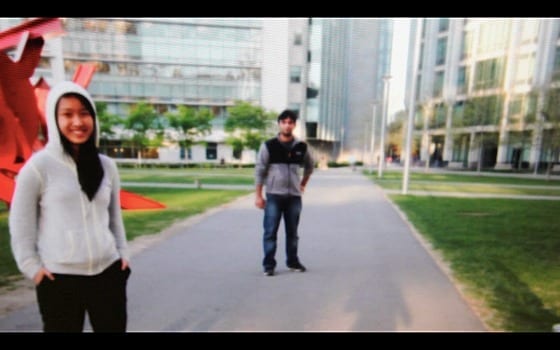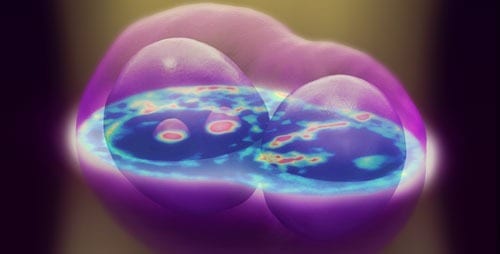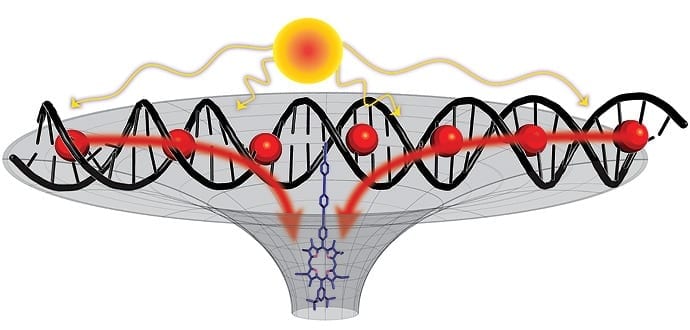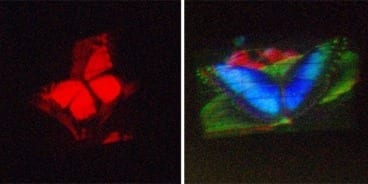
A new technique enables the conversion of an ordinary camera into a light-field camera capable of recording high-resolution, multiperspective images.
Computational photography is the use of clever light-gathering tricks and sophisticated algorithms to extract more information from the visual environment than traditional cameras can.
The first commercial application of computational photography is the so-called light-field camera, which can measure not only the intensity of incoming light but also its angle. That information can be used to produce multiperspective 3-D images, or to refocus a shot even after it’s been captured.
Existing light-field cameras, however, trade a good deal of resolution for that extra angle information: A camera with a 20-megapixel sensor, for instance, will yield a refocused image of only one megapixel.
Researchers in the Camera Culture Group at MIT’s Media Lab aim to change that with a system they’re calling Focii. At this summer’s Siggraph — the major computer graphics conference — they’ll present a paper demonstrating that Focii can produce a full, 20-megapixel multiperspective 3-D image from a single exposure of a 20-megapixel sensor.
Moreover, while a commercial light-field camera is a $400 piece of hardware, Focii relies only on a small rectangle of plastic film, printed with a unique checkerboard pattern, that can be inserted beneath the lens of an ordinary digital single-lens-reflex camera. Software does the rest.
Gordon Wetzstein, a postdoc at the Media Lab and one of the paper’s co-authors, says that the new work complements the Camera Culture Group’s ongoing research on glasses-free 3-D displays. “Generating live-action content for these types of displays is very difficult,” Wetzstein says. “The future vision would be to have a completely integrated pipeline from live-action shooting to editing to display. We’re developing core technologies for that pipeline.”
In 2007, Ramesh Raskar, the NEC Career Development Associate Professor of Media Arts and Sciences and head of the Camera Culture Group, and colleagues at Mitsubishi Electric Research showed that a plastic film with a pattern printed on it — a “mask” — and some algorithmic wizardry could produce a light-field camera whose resolution matched that of cameras that used arrays of tiny lenses, the approach adopted in today’s commercial devices. “It has taken almost six years now to show that we can actually do significantly better in resolution, not just equal,” Raskar says.
The Latest Bing News on:
Computational photography
- Mood.camera: an App for those who crave the imperfect magic of filmon April 22, 2024 at 5:36 am
In an era where phone cameras boast complex computational photography and endless editing possibilities, a growing undercurrent of nostalgia is bringing back the simple joy of old-school snaps.
- Exclusive: Google's Top Secret Camera Lab Is Like an Ikea for Pixel Testingon April 21, 2024 at 5:00 am
Google places as much emphasis on how photos and videos reflect the way you remember a moment as it does on how accurately a picture matches a color chart.
- “Beyond Physics.” How Google Pushes Phone Photography Past Its Limits.on April 17, 2024 at 9:00 am
We visited Google’s top-secret Pixel design studio to talk to Isaac Reynolds, the man in charge of building cameras for Pixel devices. We go deep on how Google uses computational photography to go ...
- I tested the Google Pixel’s Long Exposure photo mode – and it’s another reason to leave my pro mirrorless camera at homeon April 14, 2024 at 5:00 am
Long exposure is a popular technique for landscape photography and Google Pixel's dedicated mode is surprisingly effective.
- Best Camera 2024on April 12, 2024 at 7:30 am
While the best smartphones keep getting better with computational photography and crazy telephoto lenses, dedicated cameras still produce footage you just can get on your mobile device.
- Can you take eclipse photos with your phone? Yes, buton April 7, 2024 at 5:00 pm
Plus, thanks to its computational photography features, it focuses the image for you and provides image stabilization. Smartphones and optical cameras both bring unique strengths to photography.
- Best camera phones in 2024on April 7, 2024 at 2:53 pm
And that means putting cameras to the test to see how they benefit from photo-processing features and computational photography. For that reason, every phone we test goes through head-to-head ...
- How to photograph a solar eclipse with your smartphone, features and angles to consideron April 3, 2024 at 3:11 am
Plus, thanks to its computational photography features, it focuses the image for you and provides image stabilization. Be careful: Photographing the eclipse with a smartphone might damage the ...
- Looking to photograph a solar eclipse with your smartphone? Try these features and think about creative angleson April 1, 2024 at 5:00 pm
Plus, thanks to its computational photography features, it focuses the image for you and provides image stabilization. Be careful: Photographing the eclipse with a smartphone might damage the ...
The Latest Google Headlines on:
Computational photography
[google_news title=”” keyword=”Computational photography” num_posts=”10″ blurb_length=”0″ show_thumb=”left”]
The Latest Bing News on:
3-D photography
- A nature photography tour of Madagascar, part 2: The Red Tsingyon April 27, 2024 at 9:40 am
In part two of his photography tour of Madagascar, landscape photographer Erez Marom introduces us to the visually stunning Red Tsingy.
- The Top 3 Transportation Stocks to Buy in April 2024on April 27, 2024 at 5:00 am
The transportation sector literally helps to drive the U.S. economy forward. According to the U.S. Department of Transportation, the transportation and warehouse sector made up of planes, trains and ...
- May Pang shares her story of life with John Lennon in photography exhibiton April 25, 2024 at 4:30 pm
The Photography of May Pang. May's photos will be on sale, and you can meet her there. It runs at Bennett Galleries Friday, April 26 from 3 p.m. – 7 p.m., Saturday, April 27 from 10 a.m. – 5 p.m., ...
- D.C. Weekend: Petworth PorchFest, Cocktail Festival and moreon April 25, 2024 at 11:00 am
This weekend in D.C., check out Petworth PorchFest, the Georgetown French Market and the D.C. Chocolate Festival. Enjoy a full day of music by over 100 local bands and performers of various genres at ...
- The 3-Ingredient Cool Whip Candy That Tastes Like A 3 Musketeers Dupeon April 25, 2024 at 6:15 am
With just three ingredients and barely any active prep work, you can make a 3 Musketeers dupe that's completely customizable with flavorings and toppings.
- 3 Cybersecurity Stocks That Could Be Multibaggers in the Making: April Editionon April 23, 2024 at 12:00 pm
Ian Cooper, a contributor to InvestorPlace.com, has been analyzing stocks and options for web-based advisories since 1999. The post 3 Cybersecurity Stocks That Could Be Multibaggers in the Making: ...
- Photography In The National Parks: What’s In My Camera Bag Reduxon April 23, 2024 at 1:33 am
How many of you have changed your mindset about one or more aspects of photography, cameras, lenses, camera packs, or travel over the years? Contributing photographer Rebecca Latson didn’t realize ...
- Bulldog Tears Off Vet's Nose During Exam but She Doesn't 'Hold a Grudge' — Even After 3 Surgeries (Exclusive)on April 22, 2024 at 10:26 am
Veterinary oncologist Christine Merrick was treating an English bulldog last February, when he bit off her nose. It has taken three reconstructive surgeries to reverse the damage to her face.
- 3 Xiaomi 14 Ultra Features Apple Should Steal for the iPhone 16on April 20, 2024 at 4:00 am
The iPhone 15 Pro Max has a single 5x telephoto camera, so for 3x photos it relies on digital zoom. Photos taken at that magnification don't look bad, but the ones from the S24 Ultra's 3x camera look ...
- A new chapter in the history of New York street-style photographyon April 18, 2024 at 3:00 am
Watching New York,” a book inspired by Johnny Cirillo’s Instagram account of the same name, underlines how the street photography tradition has changed in the social-media era.
The Latest Google Headlines on:
3-D photography
[google_news title=”” keyword=”3-D photography” num_posts=”10″ blurb_length=”0″ show_thumb=”left”]











